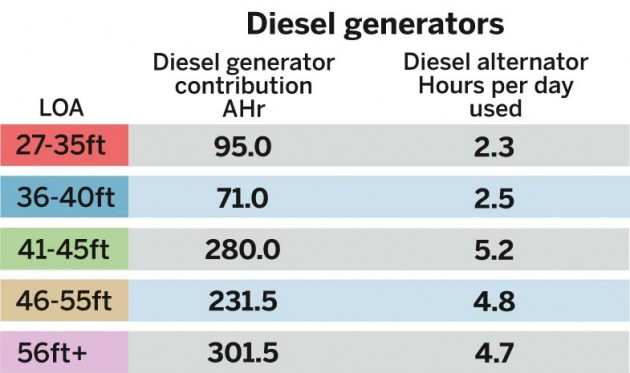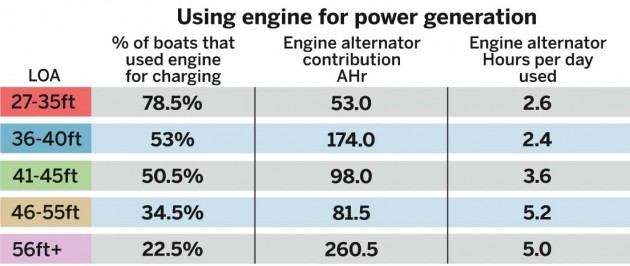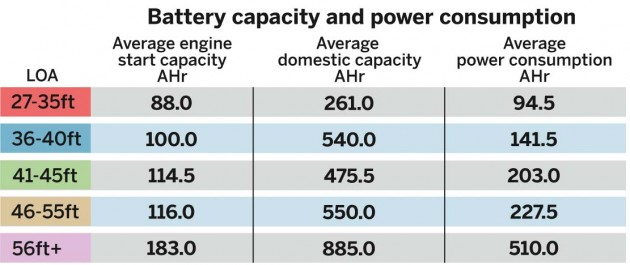We surveyed skippers in the Atlantic Rally for Cruising (ARC) 2013 to find out how they managed power generation on the crossing and afterwards in the Caribbean
We first started our ARC equipment survey 14 years ago and have been collecting data annually on the types of gear yachts carry and how skippers rate it. It’s the largest yachting equipment survey in the world, sampling the experiences of over 250 skippers taking part each year sailing over one million miles between them on the transatlantic rally from Gran Canaria to Saint Lucia.
Click here to see a breakdown of yachts, skippers/crew and the routes they took on the ARC.
The format of the survey has remained similar during this time and although the equipment people have chosen and their efficiency has varied, the conclusions are often broadly similar.
Here we investigated what seems to be the number one concern among ARC skippers: how much power on board will I need, and what’s the best way of generating it?
Power and energy
What power might a typical boat use at sea during a long passage? To give an idea, we used a sample power audit from Marlec, makers of Rutland wind generators and solar panels.
Requirement for the power to be self-sufficient is paramount on a long ocean passage. The majority of ARC boats had three battery banks and, unsurprisingly, average capacity increased with size, from 325ah among boats under 35ft rising to over 700ah for boats between 46 and 55ft and over 1,000ah for yachts over 56ft.
Most skippers in the survey in every size band had changed or added to their battery capacity since buying their boat, and in preparation for the Atlantic crossing (though, as below, in some cases it was felt not by enough). The design life for marine batteries is five years, so it makes sense to set off with new batteries; this is easier and may be cheaper than replacing them later. A majority of people had added an extra house or domestic battery bank and one or two had boosted the battery used for their windlass.
But it is worth bearing in mind that additional battery capacity will only be effective if you have the right charging set-up. The total battery capacity that can be charged with an alternator, for example, is five times alternator rating. If using a diesel generator, the output can service a larger battery bank.
A 24V system is more efficient than a 12V system, with only half its voltage loss so this is worth considering if buying a new boat for long-term cruising.
Power sources
Most smaller yachts in the survey had an engine alternator as a primary power source, with additional alternative energy sources to top this up and, on occasions, supply all power needs. At 41ft and over, diesel generators were more commonly fitted, sometimes along with other sources such as wind and water turbines, and solar panels. Indeed, wind and water sources were popular in all size ranges except those above 56ft – the larger yachts tended towards shaft generators and solar panels for additional power.
Last year we saw many more of the increasingly popular Watt & Sea water generators on a growing number of larger boats, presumably because of their efficiency at higher boat speeds and their streamlined design and relative ease of operating (though the turbine retrieval line needs a strong purchase system).
Solar panels were a valuable source of power across all the ranges, right up to the largest yachts, but made the largest contribution on boats of between 36 and 45ft, where they contributed on average 151ah and 121ah respectively.
After the ARC
We followed up on ARC participants four months after the rally to find out their views on how their set-up worked for island cruising. Alternative power sources have become so efficient that the great majority of those surveyed after the rally who felt they would make a change to their future power set-up told us they would add a water turbine or solar panels, or would add more of them. That applied even at the largest range, over 55ft, where almost every skipper who commented said they would like to add more green energy.
The consensus was to fit a range of power sources, if possible. “Don’t rely on one thing,” counselled a skipper whose diesel generator had ceased working. Solar panels come into their own in the Caribbean. The skipper of a Lagoon 380 said solar produced 99 per cent of daily demands, more than on the Atlantic crossing when they were more often in shade.
Another skipper, sailing a 36-footer, recommended a mixture of wind and solar power. “Our set-up of 350W wind generator plus three solar panels of 60W peak each fits our needs perfectly,” he commented. “We have 120ah per day for a 60lt fridge, running constantly at 8amps plus lights, VHF and SSB radio/pactor modem.”
The skipper of a Grand Soleil 43 who hadn’t fitted wind generator and solar power because he didn’t want to clutter his boat, commented: “If I were long-term cruising I would consider fitting both wind generator and solar panels, but for short-term cruising (two seasons) I don’t want to disfigure the boat.” He used a water turbine on the Atlantic crossing, but says it was: “Not useful when island hopping with short journeys and long stays. I purchased a portable petrol generator (2kVa) which is plugged into the 240V shore power inlet for a couple of hours daily.”
Another point to consider is where energy savings can be made. One of the respondents said: “Obviously there are two sides to the energy situation. Keeping consumption down helps hugely. I have fitted LED lighting throughout (they also produce less heat), and have keel-cooled refrigeration, which is very efficient.”
Battery choices
Numerous skippers in our follow-up survey said they had increased battery capacity since the rally, or would do so in future. A number said they would replace existing wet acid batteries with gel or absorbent glass mat (AGM) batteries.
Deep cycle wet lead acid batteries are still the most popular type. They are the cheapest and most versatile, easily available worldwide and they are excellent for high demand uses such as engine starting. “We still favour them because of their high charge rate,” says Will Offord from Sterling Power.
AGM batteries are more expensive than traditional flooded wet lead acid batteries. Both types are non-spill and low maintenance, and safe to use in areas that aren’t well ventilated. AGM are particularly well suited for short-term high current applications such as engine starting, while gel batteries have a better cycle capacity.
Surveyor and consultant Paul Cunningham argues that AGM have an advantage for domestic purposes because they are better suited to discharging small amounts of power over a longer term and will recover from being drawn down below 10.8V. He says: “AGM batteries are cheaper and more efficient than gel batteries, but safer than wet batteries. They are the best multi-purpose batteries.”
Lithium ion boat batteries are very much lighter than all the above, but considerably more expensive – up to ten times more. Charging has to be carefully monitored so they are a more complex and high-end choice.
Few yachts used hydrogen fuel cells, but the skipper of a Pogo 40 with an Efoy unit commented: “It makes 7ah and worked without problems.” Although expensive, they are lightweight, silent, and the only byproduct is water and a tiny amount of carbon dioxide.
What about alternative power generation? Read our feature about modern solar, wind and water power HERE










